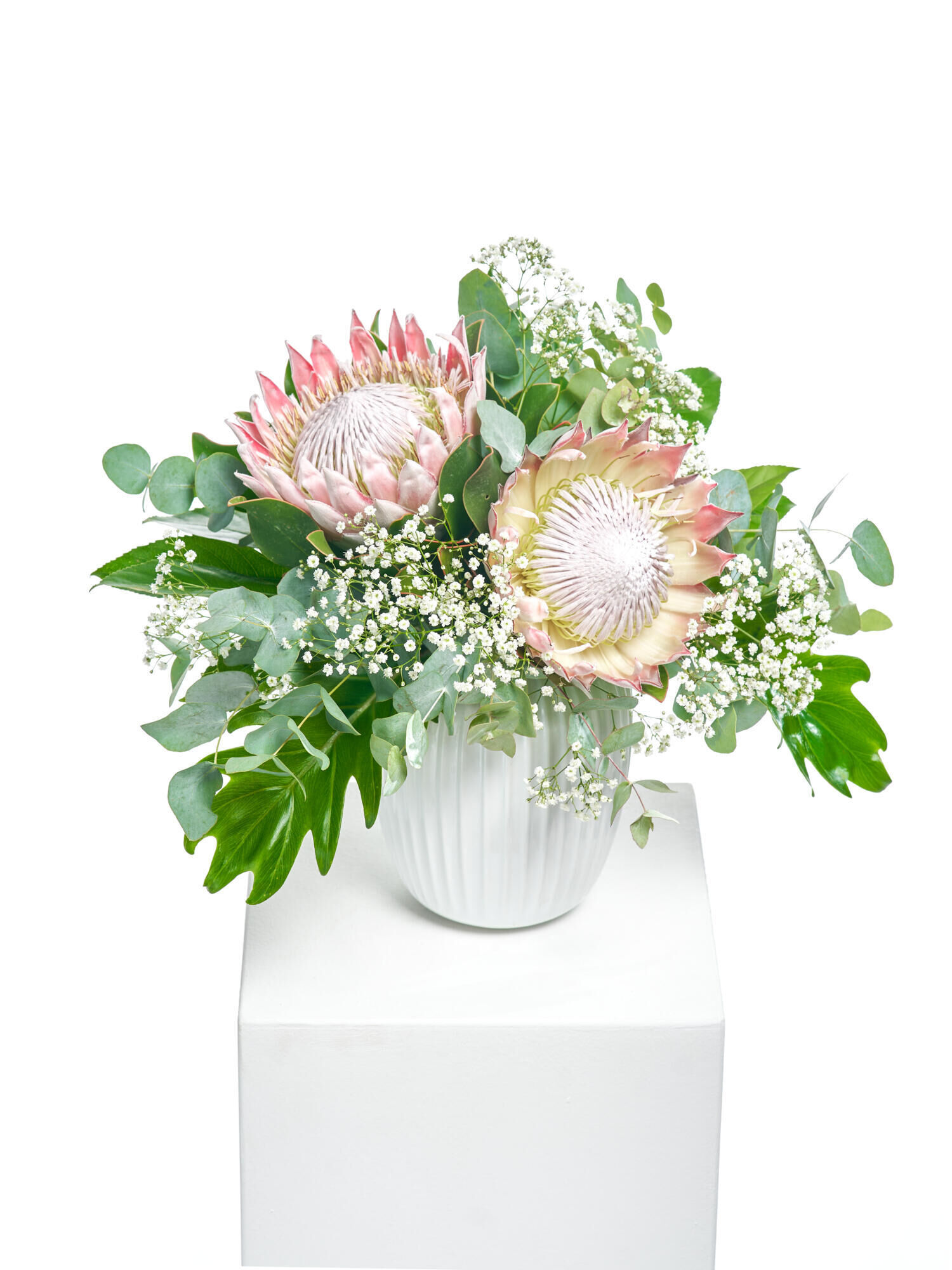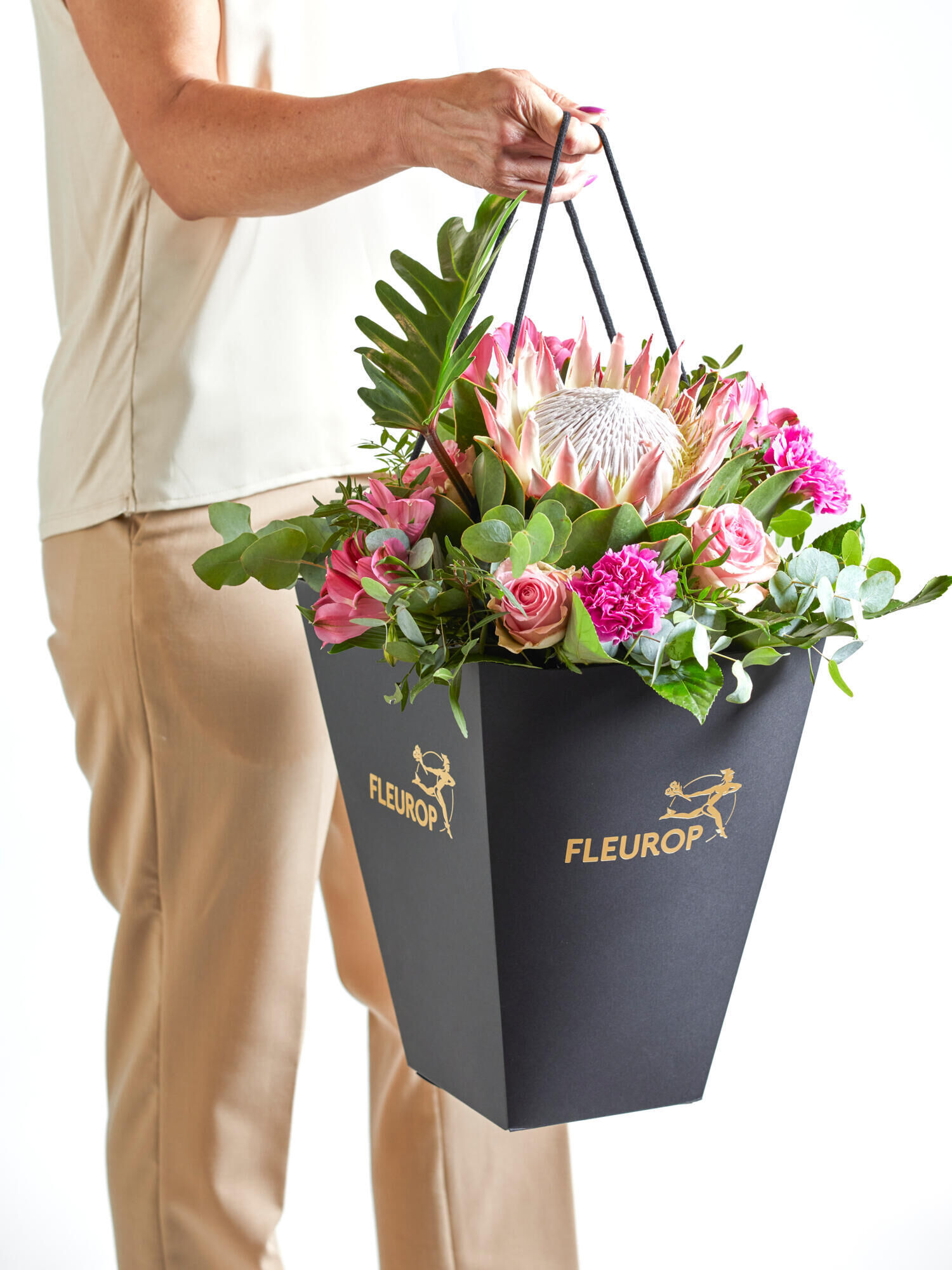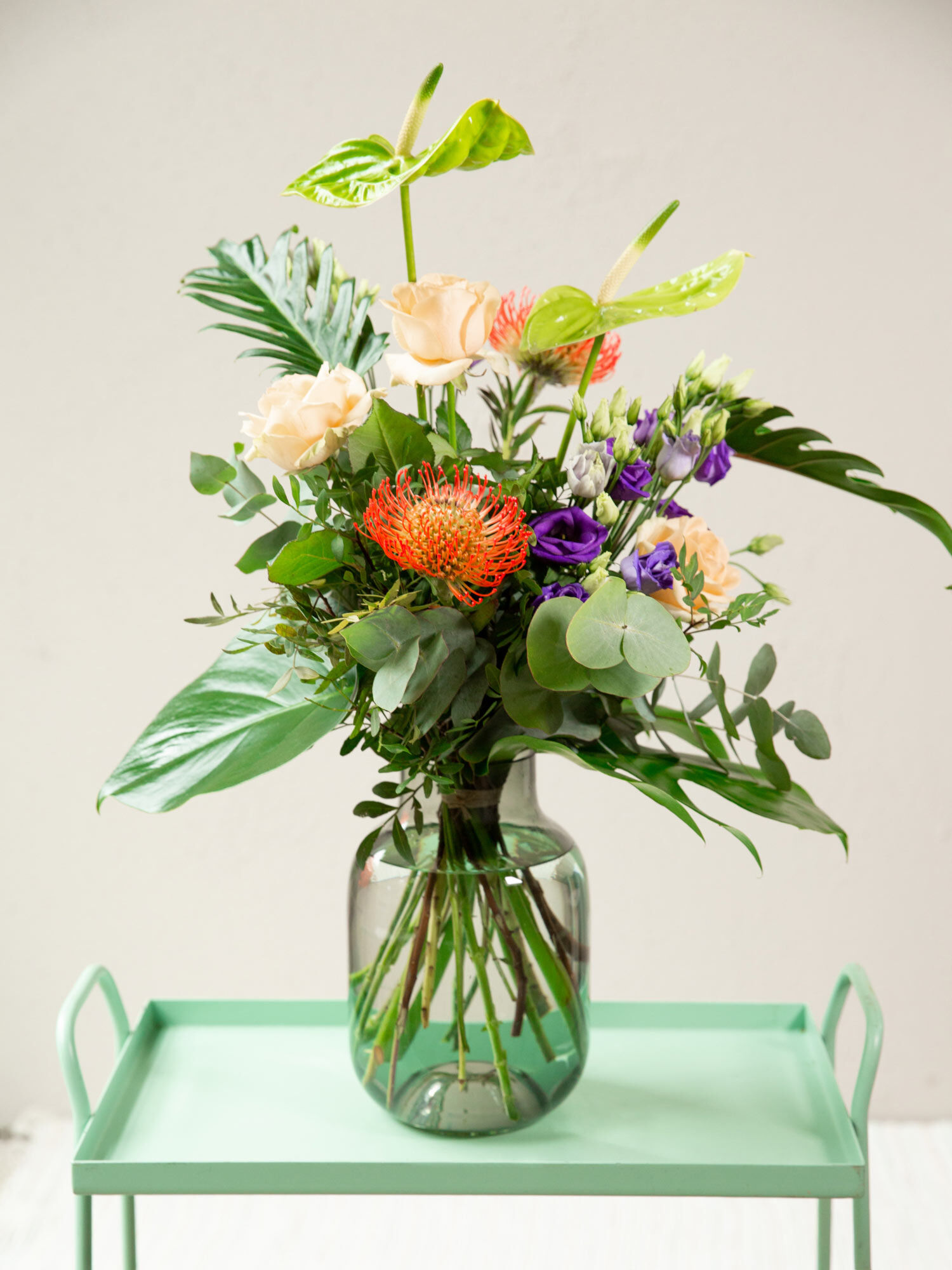Protea (sugarbush)

Have you had enough of the cold, wet dreariness of late autumn? With a little trick, you can bring South African flair into your living room. Ask your Fleurop partner florist for fresh proteas. Expertly tied into a beautiful bouquet, South Africa's national flowers will bring colourful exoticism into the grey November.
What is a protea and where does it come from?
The protea, also known as the sugarbush, is a striking and exotic flower that belongs to the silver tree family (Proteaceae). It is characterised by its large, eye-catching inflorescences and its unusual shape, which is often reminiscent of an artificial flower.
Proteas grow in the wild in South Africa in the form of sprawling bushes. Wherever you look in the African spring, the sugar bushes bloom everywhere - whether on Table Mountain or at the Cape of Good Hope. Especially in the Western Cape region, where they grow in the so-called fynbos. Fynbos means fine bush and is a rare and already protected vegetation with Protea plants. This region is known for its high biodiversity and is part of the Cape Floral Region, one of the world's most important plant kingdoms.
The protea is also the national flower of South Africa.
Meaning & symbolism of the protea
The Protea is an extraordinary flower whose beauty and diversity fascinates people all over the world. Originally from South Africa, it has conquered a special place in the flora as a robust and adaptable plant. Thanks to its magnificent, often sculptural-looking flowers and its symbolic power, the Protea is also becoming increasingly recognised in the floristry sector. It not only stands for visual appeal, but also has a deep-rooted symbolism that makes it a popular gift for special occasions and an inspiring message carrier.
The protea symbolises diversity and adaptability, as it comes in numerous colours, shapes and sizes and can adapt to a wide variety of environments. Its ability to thrive in harsh environments such as the South African fynbos makes it a symbol of strength and resilience. Due to its extraordinary, artistic appearance, it also stands for individuality and the appreciation of the unique. The name ‘Protea’ is therefore symbolic of change, versatility and adaptability and is often seen today as a symbol of perseverance and resilience.
What significance does the protea have in different cultures?
In South Africa, where the protea is native, it has a special significance as the national flower. It symbolises national unity, diversity and the strength of the South African people. The Cape Floral Region, its natural home, is rich in flora and the Protea is seen as a symbol of this unique plant diversity and the pride of the country.
In Australia, where it also thrives due to the similar climate, the Protea symbolises resilience and adaptation to nature. Here it is a popular symbol of the ability to survive and adapt to difficult circumstances.
In spiritual circles, the protea is seen as a flower of transformation and growth. Its name comes from the Greek god Proteus, who had the ability to change his shape. It therefore symbolises change, personal development and the ability to adapt to new circumstances.
In European cultures, the protea is valued as a symbol of individuality and special beauty. Because of its striking, sculptural flower, it is often associated with unique beauty and the courage to be different. It is often used on special occasions to celebrate strength, resilience and change.
Profile & characteristics of the protea
The Protea has many names: King protea, sugar bush, Cape rose or silver tree. It originates from South Africa, belongs to the Proteaceae family and comprises around 115 species. This genus is mainly native to South Africa and grows mainly in the Fynbos region, a unique vegetation zone in the Western Cape with a Mediterranean climate. Depending on the species, it grows between 1 and 3 metres tall and prefers full-sun locations. Its flowering time varies, but is often between September and November. Protea species are known for their striking, large flower heads and come in a variety of shapes and colours such as pink, white, red and cream.
Proteas need sandy, well-drained soil and can manage with little water. They do not tolerate waterlogging as they are drought-resistant. They are sensitive to frost and are therefore more suitable for mild winters. Thanks to their robust structure, long shelf life and unusual flower shape, proteas are also very popular in floristry as cut flowers, but are ideal for dried flower arrangements or as wedding flowers.
Botanical name
The botanical name ‘Protea’ is derived from the Greek god Proteus, who had the ability to change his shape at will. Carl von Linné, the Swedish botanist who classified the plant genre in the 18th century, chose this name because of the enormous diversity and adaptability of Protea plants. Proteas come in numerous shapes, colours and sizes, which vary greatly and adapt to the specific climatic conditions of their native habitat. The name Protea thus reflects the rich diversity and adaptability of this group of plants.
What does a protea look like?
The Protea is an eye-catching and exotic flower with a striking appearance. The flower heads are large and often have a crown-like shape. In the wild, proteas form many leafy branches and flowers. Strictly speaking, however, the artichoke-like structures are not single flowers at all: each inflorescence is made up of many individual small, tightly packed flowers that are very fluffy and look more like hairs. The inflorescences are framed by spectacular, usually colourful bracts. The flowers can have different colours, often ranging from soft pink and salmon pink to bright red, orange and even white, and they are often surrounded by hard, leathery leaves. The Protea has an almost sculptural appearance and is often used as a centrepiece in flower arrangements. The ‘king protea’ (Protea cynaroides) is the best known and largest species, with a flower head that can reach up to 30 cm in diameter, giving it a majestic appearance. The pincushion (Leucospermum) is particularly known for its spherical inflorescences, which resemble colourful pincushions and often shine in bright colours such as orange, red or yellow.
Growth type & height - How tall can a protea flower grow?
In the wild, the various Protea species grow as evergreen, creeping to upright shrubs and small trees. Some of the smaller species remain at a height of around 30 to 60 cm, while larger species can reach a height of up to three metres, in rare cases even up to ten metres. The king protea (Protea cynaroides), the largest and best-known species, can reach a height of up to 2 metres in the wild, with its flower head often measuring an impressive 20 to 30 cm in diameter. Smaller Protea species, such as Protea repens, are more compact and are particularly suitable for gardens and as cut flowers in floristry.
Flower colour - What colours do protea flowers come in?
Protea flowers come in an impressive variety of colours. The most common colours are pink and salmon pink, particularly typical of the king protea (Protea cynaroides) and other related species, although the king protea is also very popular in creamy white. There are also bright red flowers, such as those of Protea compacta, as well as creamy white to white flowers, which give some Protea species an elegant appearance. Yellow and orange-coloured flowers are rarer, but are found, for example, in the Protea aurea (shuttlecock sugarbush). The ‘Blushing Bride’ Protea is popular for weddings or as a delicate counterpart to the strong Protea; it has branched, soft pink to creamy white flowers, usually with a slight colour gradient. The pincushion, whose appearance gives no indication that it comes from the Protea family, has also been very popular for many years with its whimsical shape and bright colours (orange, yellow).
The Protea is characterised by its leathery, green leaves. Its characteristic conical inflorescences usually reach diameters of three to 15 centimetres.The hard bracts can be leathery and smooth or velvety and woolly.Sometimes they are strikingly brightly coloured.Some petals are multicoloured and show a pink colour with a white or greenish edge, for example, which enhances the already interesting appearance of the flowers.The bright colours of the petals often contrast vividly with the dark green, leathery leaves of the plant.
Flowering time - When does the Protea flower?
When autumn arrives in Central Europe, spring begins in South Africa - the Protea's flowering time.The flowering times of the Protea vary depending on the species and region in South Africa.Many Protea species flower in the South African spring, which lasts from September to November.In the Fynbos region, the Protea's flowering period begins in June and extends until the start of summer in November.
Throughout the spring, the otherwise green bushes bloom in ever-changing colours. First the pink Protea, then the white Protea. In Germany, the Protea mainly flowers in the late summer to early winter months, i.e. from around August to December. However, as it is not a native plant and requires special climatic conditions, it is often offered in Germany as a cut flower from imports (mainly from South Africa). It is hardly suitable for the garden in Germany as it is sensitive to frost and could only overwinter in mild, frost-free regions with special protection. The flowering period as a cut flower is therefore orientated to the South African main season and is available here from late summer to winter.
Proteas need a lot of light to grow healthily and flower well. In their natural environment, especially in the sunny regions of South Africa, they are used to full sun and thrive best when they receive at least 6 hours of direct sunlight per day.
In the garden, Proteas should be planted in a sunny, well-ventilated location.As potted plants indoors, a very bright location is also important, preferably near a window with plenty of direct light. A lack of light can result in the plant flowering less or not at all and its overall growth being inhibited.
Proteas prefer dry to moderately moist soil and are sensitive to waterlogging, as their roots can easily rot. The soil should be well-drained and sandy to slightly gravelly so that excess water can drain away quickly. A slightly acidic pH value is ideal, as Proteas do not tolerate lime and too many nutrients well.
When watering, it is better to water less than too much.The soil should dry out well between waterings and it is better to water the plant only when the top layer of soil is dry. During dry periods or in particularly hot weather, occasional watering may be necessary, but always sparingly and only enough to keep the soil slightly moist but not wet.
Proteas are poisonous and should be kept out of the reach of children and pets. They should not be eaten, as this can irritate the mucous membranes.
The Protea is generally not hardy and does not tolerate severe frosts. Most Protea species originate from the mild, frost-free regions of South Africa and prefer temperatures above 5 °C. The ideal location is one where it can be kept as brightly lit as possible and at a temperature of around ten degrees Celsius. In exceptional cases, the Protea can withstand temperatures as low as zero degrees Celsius for short periods, but this should be avoided so as not to jeopardise the plant. At temperatures below freezing, the plant can suffer damage or die. It is therefore important to protect them from frost in cooler climates.
When it comes to heat, proteas are true survivors: if it gets 40 or even 45 degrees in the South African summer, the plants are not damaged. They even survive bush fires, which are not uncommon in South Africa. Although the old bushes burn down, the new greenery appears within a few months and covers the mountains again. The trick is that many species form a thickening at the base of the trunk just below or above the ground, from which the plants sprout again after a bush fire. Even the hard-encapsulated seeds can cope with the heat. At the same time, the ash after the fires forms new nutrients for the otherwise very mineral-poor soils of the region.
Species diversity - What types of Protea are there?
Around 115 different Protea species are known, around four-fifths of which are found in southern Africa and around one-fifth in tropical Africa.
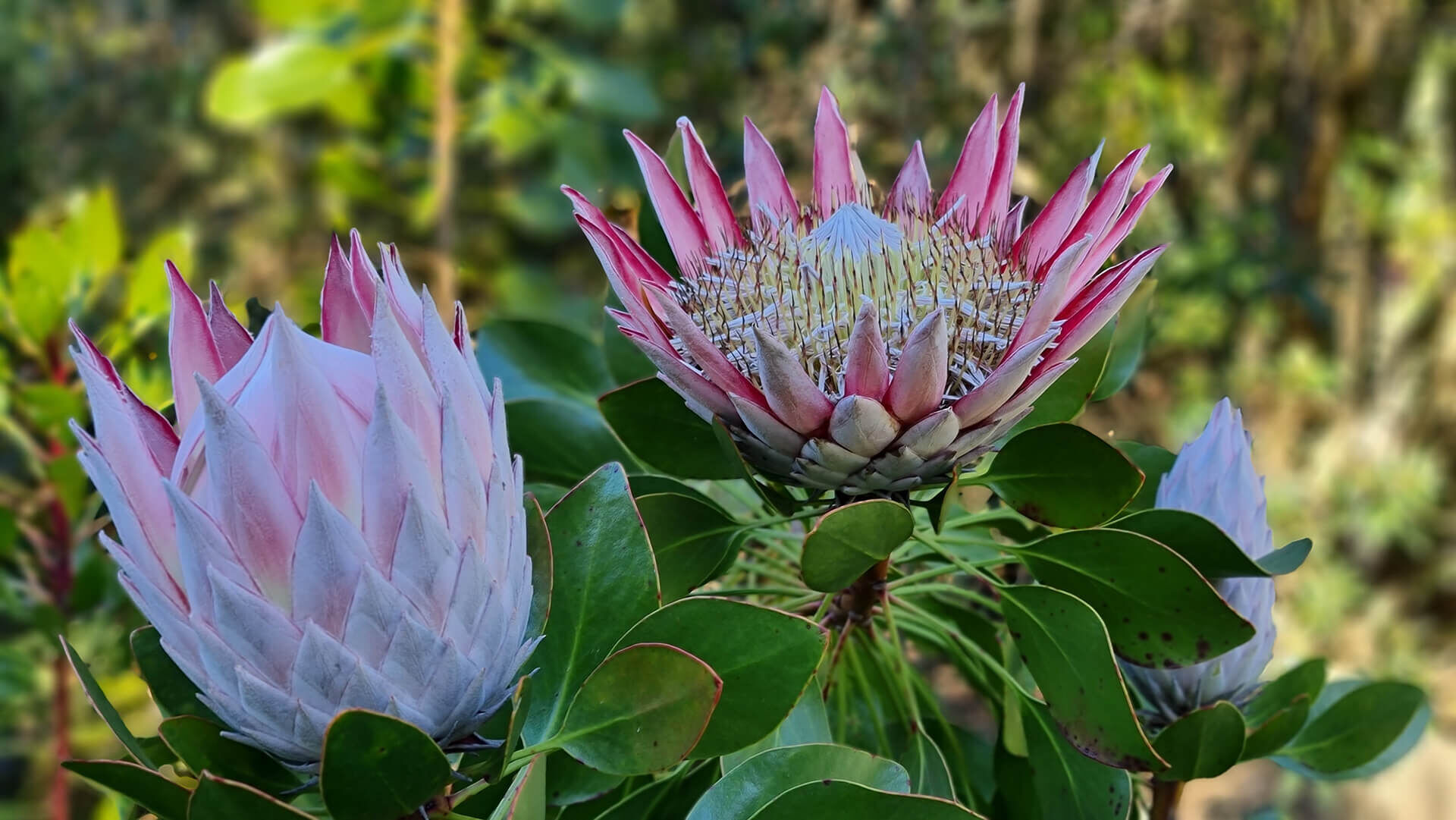
king protea
The king protea (Protea cynaroides) is a particularly beautiful species. Its flowers can reach a diameter of up to 30 centimetres! It can be found stylised on the South African coat of arms.
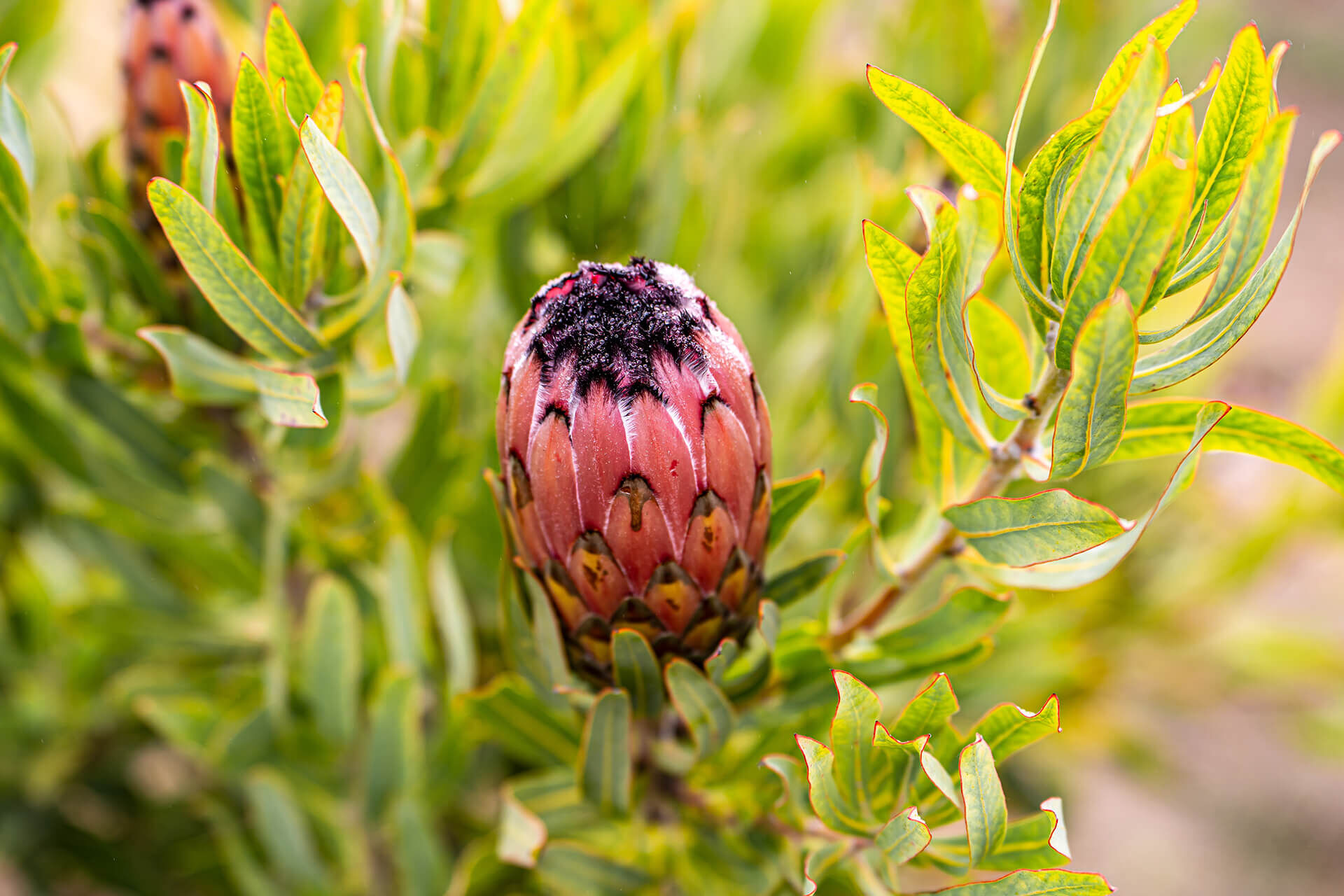
oleander-leaved Protea
The oleander-leaved Protea (Protea neriifolia) is robust and well suited to the garden, with elongated, leathery leaves and narrow, pink to red flowers that often have a black edge.
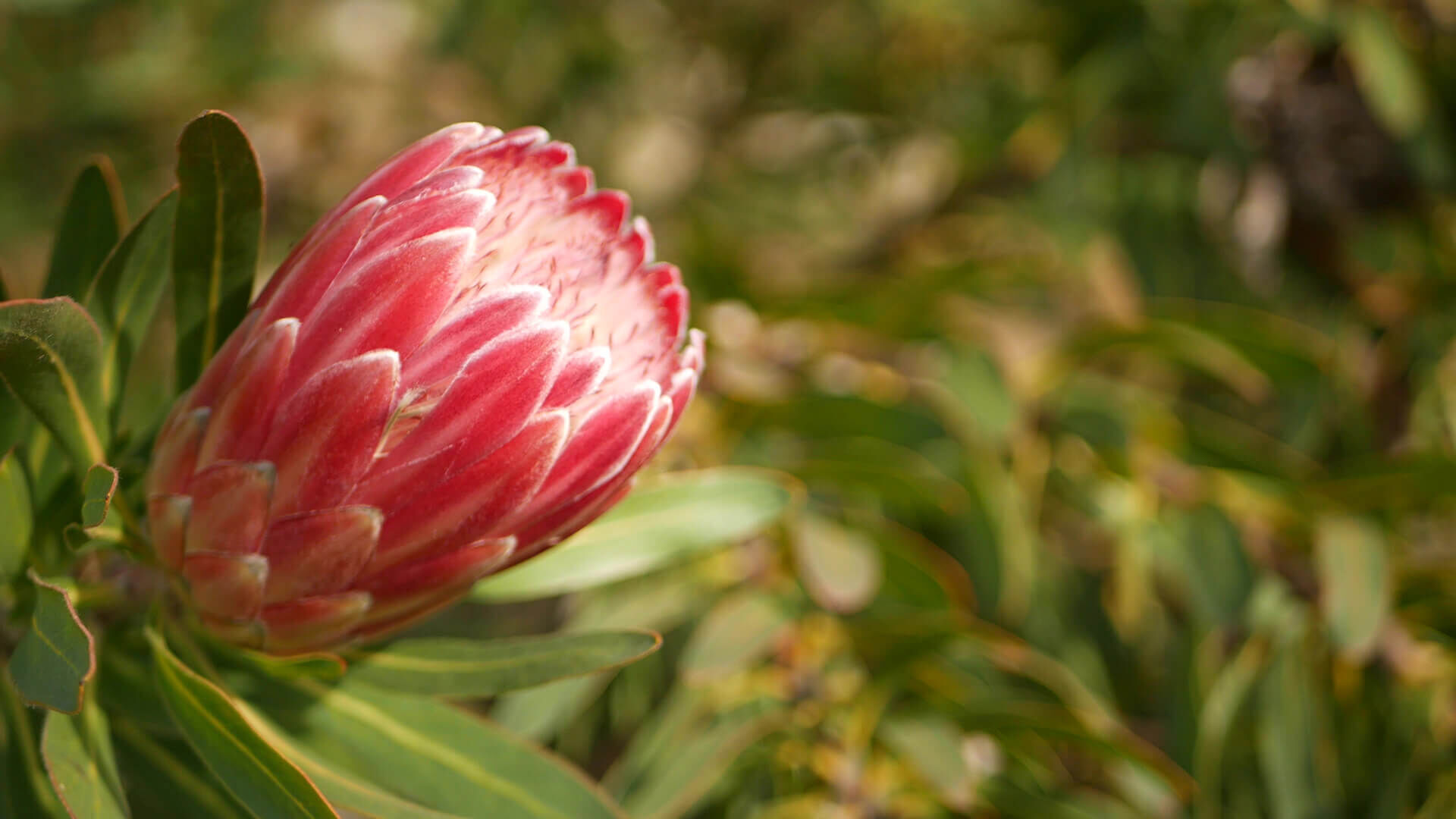
Sugarbush
Sugarbush (Protea repens) is a particularly nectar-rich, bee-friendly species that flowers in a variety of colours - from white and yellow to pink and red - and is therefore very popular with birds and insects.

narrow-leaved Protea
The narrow-leaved Protea (Protea eximia), has narrow, serrated leaves and striking reddish flowers with orange or pink tones.
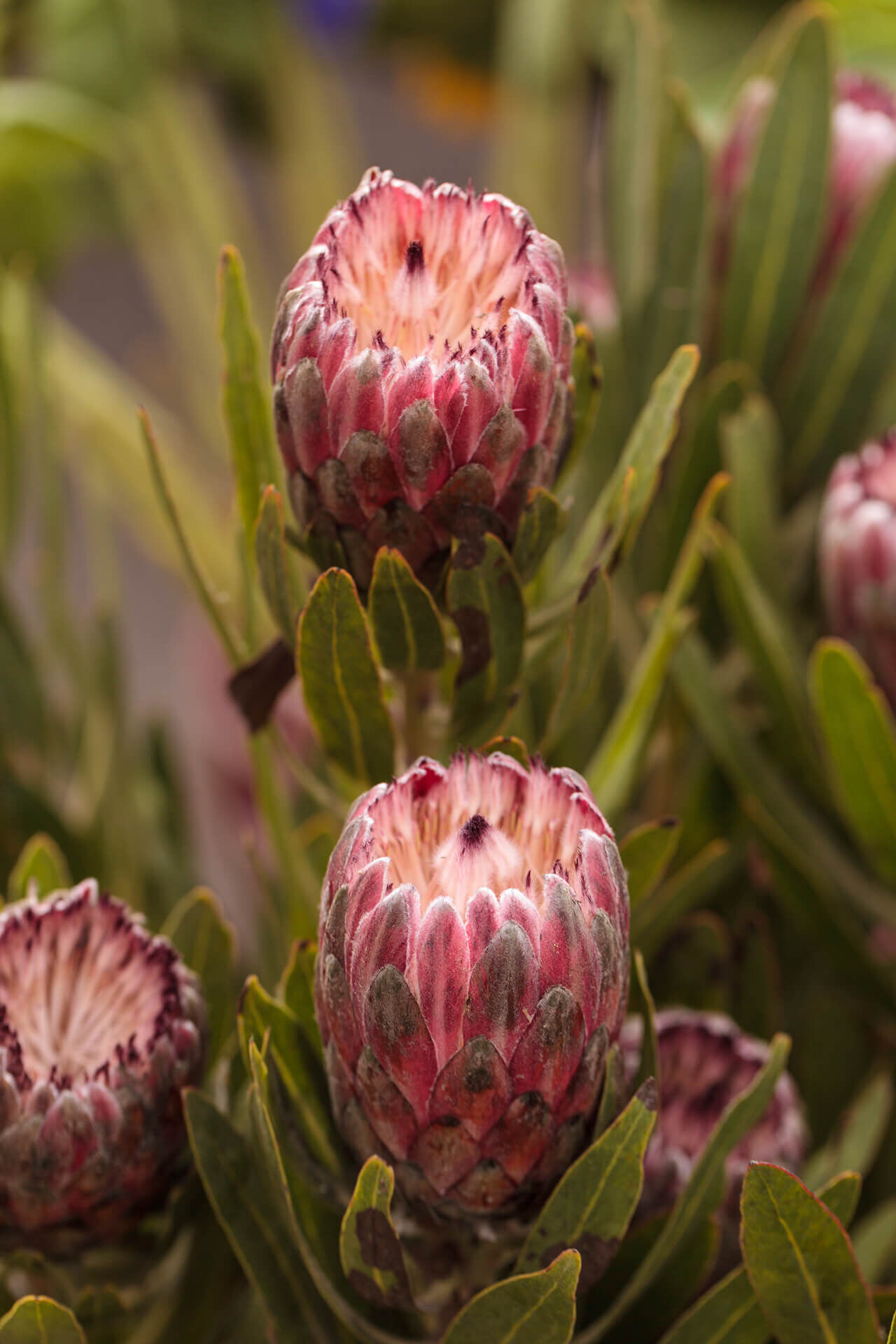
broad-leaved protea
The broad-leaved protea (Protea grandiceps), on the other hand, impresses with broad, dark green leaves and large, bright red to pink-coloured flower heads and is one of the hardier species.
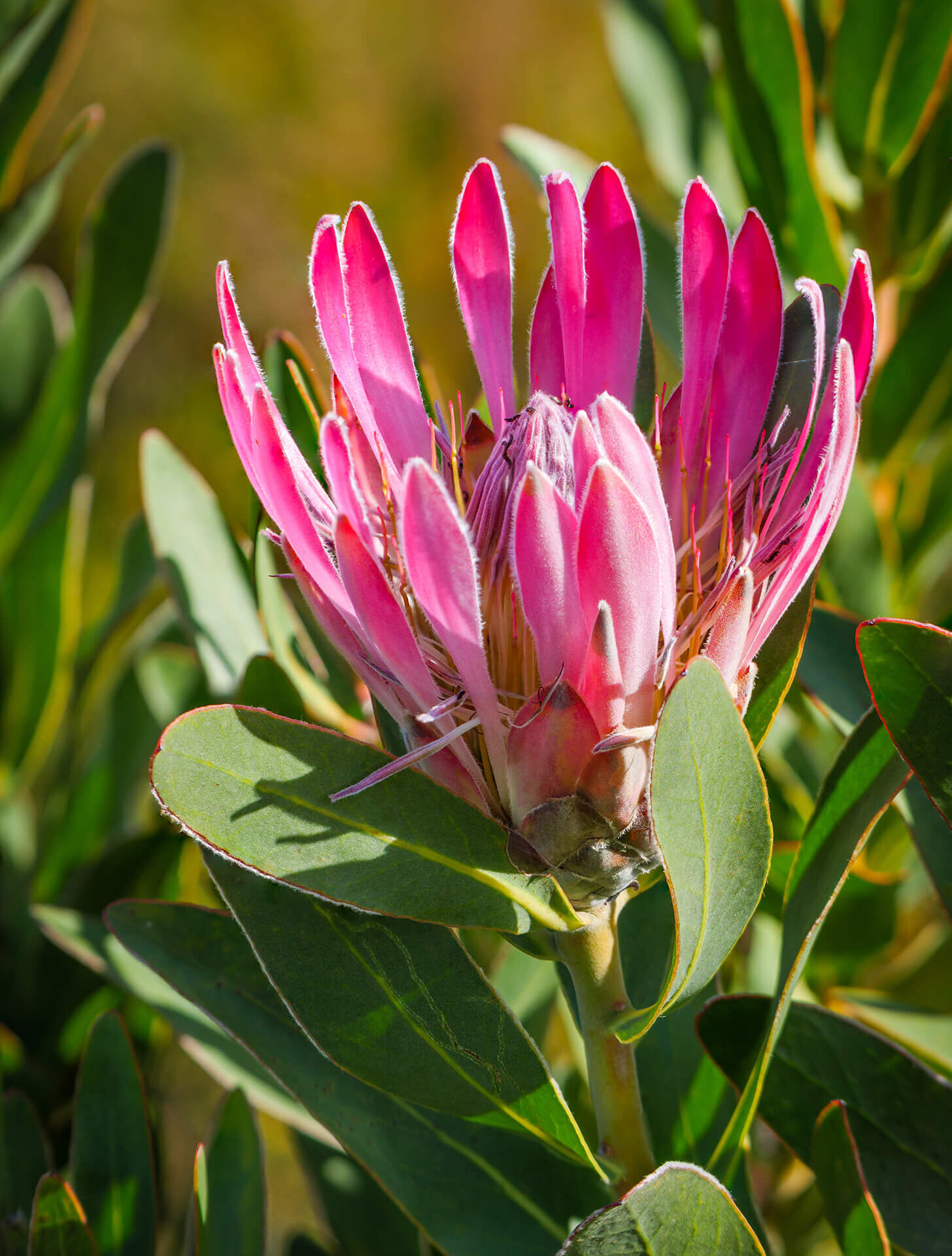
beetle bush
The beetle bush (Protea compacta) is small-growing and is well suited for garden cultivation, with flowers in strong pink to red.
The snow protea (Protea cryophila) is adapted to frosty conditions in the mountains and has whitish to pink-coloured flowers.
This species diversity of Protea shows a wide variation in leaf shapes, flower colours and sizes, which makes it particularly attractive as a cut flower or as a bridal bouquet.
Care & use of the Protea
Caring for the Protea requires some special conditions, as it is adapted to a dry and sunny climate. With the right care, the protea can thrive for many years and create a unique atmosphere. Whether as a garden, pot, cut or dried flower, its eye-catching flowers and exotic appearance make the Protea a versatile and unusual plant.
How do I care for a Protea plant?
Protea care requires sunny locations and well-drained, slightly acidic soil. It needs at least six hours of direct sunlight a day to grow healthily and develop its flowers fully. The plant needs little water and does not tolerate waterlogging; the soil should therefore be allowed to dry out completely between waterings. Fertilising is only necessary sparingly and preferably with a low-phosphate fertiliser.
Most popular use of the Protea
Protea is a popular choice for wedding decorations and bouquets. Its eye-catching flowers and unusual shapes create elegant accents and go particularly well with modern, tropical or boho-inspired weddings. The royal protea is often the highlight in bridal bouquets.
As a cut flower, the protea is highly valued for its longevity and robustness. Its flowers last a long time and retain their colour and shape, making them ideal for flower arrangements. It is often used as a centrepiece as it adds an exotic touch to any arrangement.
Protea also remains decorative when dried and is often used for permanent arrangements. Its flower structure and colours remain intact when dried, making it perfect for long-lasting decorations.
Protea in the vase: Can I use protea flowers as cut flowers and how long do they last?
Yes, protea flowers make excellent cut flowers and are very popular in the vase due to their robustness and striking flower structure.
You don't really need a special occasion for the protea. Why not surprise a loved one with an exotic bouquet of flowers and show them that November doesn't just bring grey rainy weather, but also such timelessly elegant beauties. You'll definitely impress the recipient with a more unusual look! You only need one or two of the Protea and you have a feast for the eyes. In a vase, the Protea looks like a work of art in its own four walls.
A few care tips should be followed to prolong its life: At home, cut the thick woody stems at an angle with a clean, sharp knife and place them in warm water so that the inflorescence can develop optimally. With regular fresh watering - proteas are very thirsty flowers - and a new cut every few days, they will keep for three weeks in the vase. A bright and cool location without direct sunlight is advantageous. And you can place a few decorative stones in the vase as a ‘support’ for the Protea with its heavy inflorescence. That way it won't tip over.
Drying Protea correctly
If you want to preserve your exotic beauty as a dried flower, you should hang it upside down in a dark, well-ventilated room before it withers. With a bit of luck, it will then lose neither its colour nor its shape and can still be used in flower arrangements and decorations.
And this is how it works: Choose fresh flowers that are in good condition and show no signs of wilting. Cut the stems to the desired length and remove excess leaves to prevent mould growth. To dry, tie the stems together and hang upside down. A dark room protects the colours of the flowers from fading due to sunlight. Leave to hang for two to three weeks until they are completely dry.
After drying, a light spray of hairspray or special flower fixing spray can optionally be applied to further protect the dried flowers and extend their shelf life. Dried in this way, the protea flowers remain decorative for a long time and can be used wonderfully as dried bouquets or flower arrangements.
The best time to take cuttings is in late summer to early autumn. Cut about 10-15 cm long, semi-lignified shoots and remove the lower leaves, leaving only the top two to three leaves. To encourage root growth, dip the lower end of the cutting in rooting powder. Place the cuttings in a well-drained substrate, ideally a mixture of sand and potting soil. It is helpful to place a small greenhouse or cover over the pots to keep the humidity constant. Place the pots in a bright, warm place and keep the substrate slightly moist, but not wet. The first roots should form within two to three months.
To propagate via seeds, collect them in late summer when they are ripe and soak them in warm water for 12-24 hours before planting to increase their germination capacity. Sow the seeds about 1 cm deep in a well-drained, sandy substrate and cover them lightly with soil. The pots should be placed in a warm, bright location, whereby a soil temperature of around 20 degrees Celsius promotes germination. The seeds take several months to germinate and it is important to keep the substrate slightly moist, but not wet, during this time. The germination rate is often low as Proteas are demanding.
Propagation by cuttings is usually more successful and faster. The seeds require a lot of time and also have a low germination rate. Both methods require patience and careful care in order to grow a healthy, strong plant from a Protea.
Protea plants are relatively hardy, but can be affected by diseases such as root rot, grey mould and leaf spot, as well as pests such as aphids, thrips and special protea beetles. Root rot is usually caused by too much moisture - good drainage and moderate watering are therefore important. Grey mould and leaf spot disease can be combated by improving air circulation, removing affected parts of the plant and, if necessary, using fungicides. Pests such as aphids and thrips can be rinsed off with water or treated with natural insecticides. Regular checks and optimum care help to combat diseases and pests at an early stage and keep the plant healthy.
Frequently asked questions
Yes, Protea can be grown in the garden, but the plant is only suitable for outdoor cultivation in mild, frost-free regions. It prefers a sunny, wind-protected location and requires well-drained, slightly acidic soil. As Proteas does not tolerate waterlogging, a sandy, gravelly substrate is ideal.
In regions with cold winters, Proteas are best grown in pots so that they can be brought into a frost-free winter habitat in autumn. Planted out in the garden, they could be damaged by frost. With the right care, the Protea can thrive in the garden and impress with its exotic blooms if the site conditions are right.
Yes, protea flowers are very bee-friendly and also attractive to other pollinators! Their flowers are rich in nectar and attract a variety of pollinators, including bees, butterflies and even birds. Especially in their native South Africa, proteas play an important role in the ecosystem and provide food sources for pollinators.
In a garden that favours biodiversity, proteas can therefore be a valuable addition and help to promote bees and other pollinating insects.
Protea flowers are ideal for special occasions because of their exotic beauty. At weddings, they add an elegant, tropical touch to bridal bouquets and decorations with their striking shape and colour. They are also a decorative eye-catcher as long-lasting cut flowers for birthdays and anniversaries. For corporate events and luxurious galas, proteas look exclusive and stylish, while at theme parties they enhance the ambience with tropical flair. In funeral floristry, they symbolise strength and immortality and remain a lasting memory as dried flowers. Proteas are therefore suitable for many festive occasions and create unusual accents.
So: every occasion is suitable for the expressive Protea!














